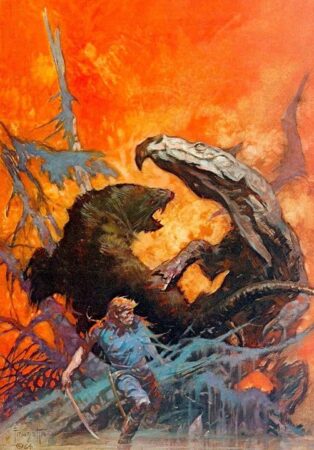
In the early 1970s, Marvel Comics began trading some of its capes and masks for swords and sandals.
Marvel’s supermen became somewhat less generous and more primitive. In contrast, their surroundings went from mundane places like New York City to fantastic ones like the Hyborian Age, ancient Atlantis, or a populated Mars.
Paperback publishers Ace, Lancer, and Ballantine had seen success in the 1960s republishing the pulp adventures of characters like Robert E. Howard’s Conan and Edgar Rice Burroughs’ Tarzan, John Carter of Mars, and Carson of Venus. J.R.R. Tolkien’s Lord of the Rings trilogy was also in paperback and becoming immensely popular. So it was natural that comics would move in the direction of swords, sinister sorcery, and super-science.
DC tried first with Nightmaster, a Howard/Tolkien-type fantasy that premiered in Showcase 82 (May 1969) but never made it past its tryout run. Then, in October 1970, Marvel hit it big with writer Roy Thomas and artist Barry Windsor-Smith adapting Howard’s Conan.
More of the same seemed to be in order, and if the rights to John Carter weren’t immediately available, the rights to similar characters were.
For Creatures on the Loose 16 (March 1972.) Thomas reached not for one of the many pastiches and knock-offs that had dogged ERB’s first hero, but for a similar character that actually preceded John Carter’s arrival in 1912.
At Marvel, Lieut. Gullivar Jones: His Vacation, a 1905 novel by an English diplomat’s son named Edwin Lester Arnold, became Gullivar Jones, Warrior of Mars. The obscure, long-vanished novel had been republished in paperback by Ace Books in 1964.
“The concept of a military man going to Mars, exploring strange civilizations, and falling in love with a princess had been explored as far back as Across the Zodiac (1880), but the connections between Gullivar and John Carter, the protagonist of Burroughs’ Barsoom novels, are more numerous and stronger,” Wikipedia notes. “Burroughs’ novel bears several striking similarities to Arnold’s. Both Carter and Gullivar are military men – Carter serving in the Confederate Army; Jones in the U.S. Navy – who arrive on Mars by apparently magical means (astral projection in the case of the former, magic carpet in the case of the latter) and have numerous adventures there, including falling in love with Martian princesses. Gullivar is a more hapless character, however, paling beside the heroic and accomplished Carter; he stumbles in and out of trouble and never quite succeeds in mastering it.”

“The hero of the story, an American naval lieutenant on leave in New York, is wandering through a slum neighborhood when an old man apparently comes tumbling out of the sky to land on his head practically at Jones’ feet,” noted Richard Lupoff in his book Edgar Rice Burroughs: Master of Adventure.
“Jones takes him to a hospital, but he is dead. A carpet found near the body somehow devolves into the officer’s possession, and as Jones, despondent at an overdue promotion, blurts out, ‘I wish I were anywhere but here, anywhere out of this red-tape-ridden world of ours! I wish I were on the planet Mars!’ the carpet flies into the air, wraps itself into an airtight cocoon with Jones inside, zooms out the window, and does not release the lieutenant until he is on (or ‘in’) Mars.”
Although Marvel’s Warrior of Mars had the benefit of Thomas’ sprightly writing — lightly peppered with pop culture references — and Gil Kane’s lissome, dynamic art, the series was short-lived, lasting six issues before being replaced by Lin Carter’s Sword and sorcery hero Thongor.
However, in June 1977, Kane got a crack at a much more famous space swordsman when Marvel began publishing John Carter, Warlord of Mars.
